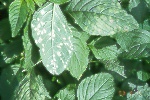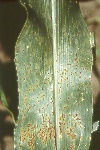Newsletter Archives |
July 2001 Newsletter
Lindsey du Toit and Debra Inglis, editorsWSU Mount Vernon NWREC
16650 State Rte 536, Mount Vernon, WA 98273-4768
360-848-6140 (tel), 360-848-6159 (fax)
WSU Vegetable Pathology Team Newsletter
Hello!
Welcome to the July 2001 edition of Washington State University's Vegetable
Pathology Extension Team. This newsletter follows the team's July conference
call when team members discussed current vegetable diseases, diagnoses and
control. Please use this information in your own newsletters and activities.
Photos needed for our website's new Vegetable Disease Gallery
We now have many excellent photographs of vegetable disease symptoms for our
new vegetable pathology team web site photo gallery, but we eventually wish
to post additional slides at: https://mtvernon.wsu.edu/path_team/galleryconstr.htm
We believe this vegetable disease "photo gallery" will be
one way you can quickly access and reference images of vegetable disease symptoms.
To contribute, contact dainglis@wsu.edu
Need to know about cultural management options & Washington-registered
pesticides for home gardens?
Check out the vegetable section of WSU's Hortsense website. Information about
cultural management options and current pesticide recommendations available
to home gardeners for Washington-registered pesticides on asparagus, beans,
chard, broccoli, crucifers, cantaloupe, melon, carrot, corn, pumpkin, squash,
lettuce, onion, garlic, pea, pepper, eggplant, potato, radish, spinach, tomato,
turnip and rutabaga can be found at: https://pep.wsu.edu/hortsense/
WSDA websites are now on-line
Washington State Department of Agriculture Pesticide Management Division:
https://www.wa.gov/agr/pmd/
Pesticide recertification course database:
https://www.wa.gov/agr/pmd/licensing/recertification.htm
Register Now for the 29th International Carrot Conference
The conference will be held February 10-13, 2002 at the Holiday Inn Select,
Bakersfield, CA. View: https://www.co.kern.ca.us/farm/farm.htm
for more information.
Want to know more about economically important diseases of asparagus
in the U.S.?
View the recent feature story on APSnet at:
https://www.apsnet.org/online/feature/asparagus/top.htm
Vegetable Diseases/Issues
and Places to Find Information
"A Whiter Shade of Pale" – Is
this rust or white rust?
In the June newsletter, we focused
on differences between downy and powdery mildew. These two diseases are sometimes
confused with one another, but actually are distinct. Two other foliar diseases
on vegetable crops that may be confused with one another are rust and white
rust. Like the downy and powdery mildews, both rusts are obligate parasites
and require an association with host tissue for long term survival. However,
just as the downy and powdery mildew organisms belong to different groups
of pathogenic fungi, rust is a basidiomycete while white rust is an oomycete.
This means that different types of fungicides are required for their control.
The following comparisons might be useful for distinguishing between the two
types of rust. Both types of rusts form pustules which can rupture host epidermal
cells and reveal powdery spore masses (hence the name "rust"). Rust may produce
up to five distinct fruiting structures and spore forms which appear in sequence
(teliospores, basidiospores, pycniospores, aeciospores and urediospores) although
many rusts produce only one or a few of these spore types. In contrast, white
rust produces sporangiospores, zoospores and oospores. Note that no crop is
affected by both, and that white rust affects cruciferous plants primarily.
| Rust | White Rust (Albugo candida) | |
| Common vegetable hosts in Washington and the rust species affecting them |
Asparagus (Puccinia
asparagi) |
----- |
| Conditions favoring infections | Generally, rust is favored
by moderate temperature and high humidity and moisture
For beet rust, if the tops of beet are destroyed by the disease, it may be difficult to pull the beets from the ground For common rust on corn, wood sorrel (Oxalis spp.) is an alternate host; common rust is only seen occasionally in the PNW For onion rust, seed yield may be reduced if seed stalks become girdled |
Leaf infection occurs readily at 68°F when free water is present. Long periods of free water inhibit spore germination because spores must dry before germination occurs. The disease is known throughout the world where crucifers are grown, and many cruciferous weeds are hosts. |
| Cultural management strategies | Plant resistant cultivars
|
Locate fields away from established susceptible crops; control wild mustards; plant resistant cultivars; incorporate debris into soil after harvest |
| Generalized disease cycle | Overwinters on old stems;
the summer spore stage (uredial stage--probably the most damaging stage),
is windborne and may go through several cycles in one growing season. |
Overwinters as oospores in plant debris or mycelium in perennial plants. Secondary infections occur by windborne sporangiospores which invade the stomata by germ tubes. |
| Typical signs and symptoms | On
asparagus: the winter stage consists of oval yellowish spots on stems;
these spots contain the fruiting bodies (aecia and pycnia) of the fungus;
the summer spore stage consists of pustules (uredia) which are brown and
powdery; the autumn stage is made up of black spore masses (telia)
|
Small light green spots which later turn white and finally result in blisterlike raised white pustules. Seedlings may be abnormally shaped if infection is early; late infections in seed crops may cause distorted outgrowths called "staghorns"  White rust on Amaranthus
|
| . | Note: On corn: There are two different rusts on corn. P. sorghi causes common rust which sometimes occurs in the PNW, and P. polysora causes southern rust which occurs primarily in the southeastern US. Common rust pustules (uredia) can be found on upper & lower leaf surfaces whereas southern rust pustules, which are lighter brown, usually are more numerous on upper leaf surfaces, ears, stalks and/or leaf sheaths. |
|
Visit The Skagit Veg Trials
The Skagit Veg Trials, an annual vegetable trial and display garden, was added to the Skagit Display Gardens at the WSU-Mount Vernon Research and Extension Unit this spring. The aim of the project, led by Dr. Wilbur 'Andy' Anderson and sponsored by the Skagit Men's Garden Club, is to identify the best available vegetable varieties and cultural practices for the Puget Sound maritime climate. Identifying varieties that emerge in cool soils and have a range of maturities – early, mid and late – allows the commercial or home gardener to plant at one time but harvest over a long period.
The project will work its way through the major vegetables over a 6 or 7 year period. This year's trials include 45 varieties of peas and 185 varieties of corn. Three types of peas are being tested – shell, snap and snow peas. Corn trials include yellow, white and bi-color varieties in each of three sweetness levels – normal sugar, sugar-enhanced and supersweet. About 26 varieties of spinach and 30 varieties of tomatoes are also being tested. All trials are replicated in either time or in plots. The peas are replicated this year in plots. The corn will be replicated in time, that is, the varieties that do the best this year will be tested again next year. Cultural studies this year include metam-sodium fumigation for weed and disease control, and spray blade fumigation to control weeds and diseases in the planted rows.
For directions to the Trials and a list of trial activities, contact Nancy Ligget at liggett@coopext.cahe.wsu.edu
The Puget Sound Fresh web site (https://www.pugetsoundfresh.org) presents descriptions of western Washington farms and the crops they produce for consumers. Farms can advertise for free on this web site.
Upcoming
Vegetable Events
Check out the Vegetable Pathology
Team's calender of upcoming events:
https://mtvernon.wsu.edu/path_team/vegpath_team.htm
Our pages provide links to external sites for the convenience of users. WSU Extension does not manage these external sites, nor does Extension review, control, or take responsibility for the content of these sites. These external sites do not implicitly or explicitly represent official positions and policies of WSU Extension.

